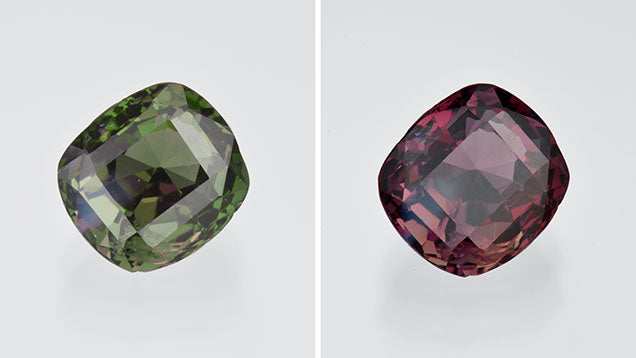Emma Scaramozzino - July 20, 2021
EVERYTHING YOU NEED TO KNOW ABOUT: ALEXANDRITE
It's finally here - everything you need to know about June's other birthstone: Alexandrite
ORIGIN
Alexandrite was originally discovered in the Russian Ural Mountains during the early 1830s. Today, alexandrite is found in Tanzania, Zimbabwe, Brazil, India, and Sri Lanka. In most of these places, alexandrite is a byproduct of emerald mining. Despite alexandrite being present in so many countries, it has become increasingly scarce since the initial rush in Brazil during the early 1990s. However, demand for the gemstone has stayed high in the U.S., especially for large stones with high clarity and distinctive color change.


Source: GIA

COLOR GRADING
Color and color change are the most important factors when determining an alexandrite's value. The more saturated the alexandrite's color is, the more valuable. The same goes for color change; the more dramatic the change is between incandescent and daylight, the higher the value.
When looking for alexandrite for everyday jewelry, typically below one carat, the color scale ranges from AAAA - A. Stones are labeled with these letters based on rarity. For example, an AAAA (heirloom quality) stone accounts for the top 1% of all-natural gemstones, AAA stone (fine quality) accounts for 10%, AA accounts for 25%, A for 50 - 75% (a more commercial-grade stone).
When looking for an alexandrite stone that is fine quality (typically over one carat), you would ask your jeweler to find you a "Gem". Gem is a term used to describe the best quality in gemstones, for any size above one carat. In the case of alexandrite, a gem should have exceptional color change. And if a client is specifically looking for natural alexandrite, the origin will most likely be Brazil.


Source: gemsny.com
CLARITY GRADING
Like other precious gems, the value of alexandrite is determined not only by their color but also their clarity. Though clarity is taken into account when grading smaller stones or "melee" on the AAAA-A scale, larger stones are looked at more closely for inclusions. Eye clean, very slightly included, slightly included, moderately included, and included are all grades on the alexandrite scale. However, color and color change takes priority when determining the value of the stone.

Source: GIA
INCLUSIONS
There are many types of inclusions that can be found in alexandrite. Needles, crystals, and twinning are similar inclusions to the ones you can see in diamonds. However, fluorite, apatite, mica platelets, rutile, and multi-phase inclusions are inclusions commonly found in alexandrite because of the elements present during the growth process. Fingerprints, liquid inclusions, and hollow tubes are also common, though these types of inclusions can be seen in other precious stones regardless of the elements present.



Source: GIA
LUSTER
Luster is the way light interacts with the surface of a stone. Also known as crystal or the "life" in a stone, this seemingly slight difference between stones can raise the price of a gem significantly. Luster is an extremely important factor in determining an alexandrite's value because the stone's interaction with light is what causes its color change.

Source: GIA
TREATMENTS
Although treatments are rarely applied to alexandrite, occasionally you will find stones with oil-filled fractures. The process is similar to the oil treatment performed on emeralds. Palm oil, also known as Palma, is the most commonly used oil to enhance the stone's clarity. This further improves its overall quality and grade.

Source: Ayana Jewellery
DENSITY
The density of a stone is what determines its carat weight. Because density varies between different types of stones, carat weight differs even if two stones have the same dimensions. For example, if an alexandrite is 9x7mm it weighs in at around 2.96 carats. However, a 9x7mm emerald weighs in at about 2 carats.

Source: Diamond Advisor
CERTIFICATES
When purchasing a large alexandrite, especially as the center stone of an engagement ring, you may receive a certificate along with it. Certifications typically come from notable labs such as GIA, Lotus, AIGS, CDC, and IGI.


Source: GIA
LAB GROWN ALEXANDRITE
Just like diamonds, lab-grown alexandrite is 100% atomically the same as natural alexandrite. They are also significantly less costly due to the scarcity of the natural stone. On average, a one carat gem quality alexandrite can cost you anywhere from $12,000 to $18,000. A cultivated stone is typically 10% of that or less .

Source: Pinterest
BIRTHSTONE MEANINGS + HEALING PROPERTIES
Alexandrite is said to bring creativity, good fortune, and love to those that carry or wear the stone. It is also believed to aid in healing chronic illnesses and accelerate the recovery process of someone who has had surgery or a prolonged illness.

Source: Shahla Karimi










